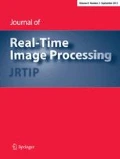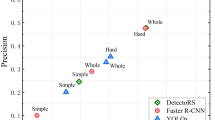Abstract
Target detection is an important technique in hyperspectral image analysis. The high dimensionality of hyperspectral data provides the possibility of deeply mining the information hiding in spectra, and many targets that cannot be visualized by inspection can be detected. But this also brings some problems such as unknown background interferences at the same time. In this way, extracting and taking advantage of the background information in the region of interest becomes a task of great significance. In this paper, we present an unsupervised background extraction-based target detection method, which is called UBETD for short. The proposed UBETD takes advantage of the method of endmember extraction in hyperspectral unmixing, another important technique that can extract representative material signatures from the images. These endmembers represent most of the image information, so they can be reasonably seen as the combination of targets and background signatures. Since the background information is known, algorithm like target-constrained interference-minimized filter could then be introduced to detect the targets while inhibiting the interferences. To meet the rapidly rising demand of real-time processing capabilities, the proposed algorithm is further simplified in computation and implemented on a FPGA board. Experiments with synthetic and real hyperspectral images have been conducted comparing with constrained energy minimization, adaptive coherence/cosine estimator and adaptive matched filter to evaluate the detection and computational performance of our proposed method. The results indicate that UBETD and its hardware implementation RT-UBETD can achieve better performance and are particularly prominent in inhibiting interferences in the background. On the other hand, the hardware implementation of RT-UBETD can complete the target detection processing in far less time than the data acquisition time of hyperspectral sensor like HyMap, which confirms strict real-time processing capability of the proposed system.


















Similar content being viewed by others
References
Goetz, A.F.H., Vane, G., Solomon, J.E., Rock, B.N.: Imaging spectrometry for earth remote sensing. Science 228(4704), 1147–1153 (1985)
Manolakis, D., Shaw, G.: Detection algorithms for hyperspectral imaging applications. IEEE Signal Process. Mag. 19(1), 29–43 (2002)
Nasrabadi, N.M.: Hyperspectral target detection: an overview of current and future challenges. IEEE Signal Process. Mag. 31(1), 34–44 (2013)
Eismann, M.T., Stocker, A.D., Nasrabadi, N.M.: Automated hyperspectral cueing for civilian search and rescue. Proc. IEEE 97(6), 1031–1055 (2009)
Qian, Y., Yao, F., Jia, S.: Band selection for hyperspectral imagery using affinity propagation. IET Comput. Vision 3(4), 213–222 (2009)
Dias, J.M.B., Plaza, A., Dobigeon, N., Parente, M., et al.: Hyperspectral unmixing overview: geometrical, statistical, and sparse regression-based approaches. IEEE J. Sel. Topics Appl. Earth Obs. Remote Sens. 5(2), 354–379 (2012)
Chang, C.I., Sun, T.L., Althouse, M.L.G.: An unsupervised interference rejection approach to target detection and classification for hyperspectral imagery. Opt. Eng. 37, 735–743 (1998)
Du, Q., Ren, H.: On the performance of CEM and TCIMF. Proc. SPIE Int. Soc. Opt. Eng. 5806, 861–868 (2005)
Matteoli, S., Diani, M., Corsini, G.: A tutorial overview of anomaly detection in hyperspectral images. IEEE Aerosp. Electron. Syst. Mag. 25(7), 5–27 (2010)
Stein, D.W.J., et al.: Anomaly detection from hyperspectral imagery. IEEE Signal Process. Mag. 19(1), 58–69 (2002)
Kraut, S., Scharf, L.L., Butler, R.W.: The adaptive coherence estimator: a uniformly-most-powerful-invariant adaptive detection statistic. IEEE Trans. Signal Process. 53(2), 417–438 (2005)
Robey, F.C., Fuhrmann, D.R., Kelly, E.J., Nitzberg, R.: ACFAR adaptive matched filter detector. IEEE Trans. Aerosp. Electron. Syst. 28(1), 208–216 (1992)
Chang, C.I.: Target signature-constrained mixed pixel classification for hyperspectral imagery. IEEE Trans. Geosci. Remote Sens. 40(5), 1065–1081 (2002)
Ren, H., Chang, C.I.: A target-constrained interference-minimized filter for subpixel target detection in hyperspectral imagery. In: Proceedings of IEEE 2000 International on Geoscience and Remote Sensing Symposium. IGARSS 2000. IEEE, vol. 4, pp. 1545–1547 (2000)
Zhang, B., et al.: Real-time target detection in hyperspectral images based on spatial-spectral information extraction. EURASIP J. Adv. Signal Process. 1, 142 (2012)
Gomz, R.B., Lewis, A.J.: On-board processing for spectral remote sensing. In: ISPRS Special Session Future Intelligent Earth Observing Satellites (FIEOS’02) (2002)
Plaza, A., Plaza, J., Paz, A., Sánchez, S.: Parallel hyperspectral image and signal processing. IEEE Signal Process. Mag. 28(3), 119–126 (2011)
Bing, Z.: Intelligent remote sensing satellite system. J. Remote Sens. 15(3), 423–431 (2011)
Sánchez, S., Paz, A., Martin, G., Plaza, A.: Parallel unmixing of remotely sensed hyperspectral images on commodity graphics processing units. Concurr. Comput. Pract. Exp. 23(13), 1538–1557 (2011)
Lysaght, P., Blodget, B., Mason, J., Young, J., Bridgford, B.: Enhanced architectures, design methodologies and CAD tools for dynamic reconfiguration of Xilinx FPGAs. In: Proceedings of International Conference Field Programmable Logic Applications, pp. 1–6 (2006)
Compton, K., Hauck, S.: Reconfigurable computing: a survey of systems and software. ACM Comput. Surv. 34, 171–210 (2002)
Tessier, R., Burleson, W.: Reconfigurable computing for digital signal processing: a survey. J. VLSI Signal Process. Syst. 28(1), 7–27 (2001)
Hauck, S.: The roles of FPGAs in reprogrammable systems. Proc. IEEE 86(4), 615–639 (1998)
Plaza, A., Du, Q., Chang, Y.L., King, R.L.: High performance computing for hyperspectral remote sensing. IEEE J. Sel. Topics Appl. Earth Obs. Remote Sens. 4(3), 528–544 (2011)
Gonzalez, C., Lopez, S., Mozos, D., et al.: A novel FPGA-based architecture for the estimation of the virtual dimensionality in remotely sensed hyperspectral images. J. Real Time Image Proc. 43(5), 1–12 (2015)
Wang, J., Chang, C., Cao, M.: FPGA design for constrained energy minimization. In: Optical Technologies for Industrial, Environmental, and Biological Sensing. International Society for Optics and Photonics, pp. 262–273 (2004)
Yang, B., Yang, M., Plaza, A., et al.: Dual-mode FPGA implementation of target and anomaly detection algorithms for real-time hyperspectral imaging. IEEE J. Sel. Topics Appl. Earth Obs. Remote Sens. 8(6), 2950–2961 (2015)
Gonzalez, C., Bernabe, S., Mozos, D., et al.: FPGA implementation of an algorithm for automatically detecting targets in remotely sensed hyperspectral images. IEEE J. Sel. Topics Appl. Earth Obs. Remote Sens. 9(9), 1–10 (2016)
Bernabé, S., López, S., Plaza, A., et al.: FPGA design of an automatic target generation process for hyperspectral image analysis. In: IEEE, International Conference on Parallel and Distributed Systems, IEEE Computer Society, pp. 1010–1015 (2011)
Li, C., Gao, L., Plaza, A., Zhang, B.: FPGA implementation of a maximum simplex volume algorithm for endmember extraction from remotely sensed hyperspectral images. J. Real Time Image Process. 1, 1–14 (2017)
Chang, C.I.: Target abundance-constrained subpixel detection: partially constrained least-squares methods. In: Hyperspectral Imaging: Techniques for Spectral Detection and Classification, pp. 39–41. Kluwer, New York, NY (2003)
Winter, M.E.: N-FINDR: an algorithm for fast autonomous spectral endmember determination in hyperspectral data. Proc. SPIE 3753, 266–275 (1999)
Chang, C.I., Wu, C., Liu, W., Ouyang, Y.C.: A growing method for simplex-based endmember extraction algorithms. IEEE Trans. Geosci. Remote Sens. 44(10), 2804–2819 (2006)
Dias, J.M.B., Nascimento, J.M.P.: Hyperspectral subspace identification. IEEE Trans. Geosci. Remote Sens. 46(8), 2435–2445 (2008)
Gonzalez, C., et al.: FPGA implementation of the HySime algorithm for the determination of the number of endmembers in hyperspectral data. IEEE J. Sel. Topics Appl. Earth Obs. Remote Sens. 8(6), 1–14 (2015)
Thambi, M.C., Dharan, N.B., Rajaram, S.: FPGA implementation of low cost matrix inverse computation for MIMO systems. Int. J. Appl. Eng. Res. 10(20), 15622–15626 (2015)
Tao, L.I., Zhang, Z.P.: Matrix inversion by FPGA. Commun. Technol. 43(11), 147–149 (2010)
Zhang, G., Shen, H., Shi, F., Huo, Y.: Block iterative inverse algorithm for a large-scale real matrix. Wirel. Internet Technol. 6, 127–129 (2015)
Eftestøl, T.: Controlling true positive rate in ROC analysis. Comput. Cardiol. Conf. 373(42), 353–356 (2009)
Stock, E.M., et al.: Estimation of disease prevalence, true positive rate, and false positive rate of two screening tests when disease verification is applied on only screen-positives: a hierarchical model using multi-center data. Cancer Epidemiol. 36(36), 153–160 (2012)
Cocks, T., Jenssen, R., Stewart, A., Wilson, I., Shields, T.: The HyMap airborne hyperspectral sensor: the system, calibration and performance. In Proceedings of 1st EARSEL Workshop on Imaging Spectroscopy, Zurich, Switzerland, pp. 37–42 (1998)
Acknowledgements
This work was supported by the National Natural Science Foundation of China under Grant Nos. 91638201, 41722108, 41325004 and 41571349.
Author information
Authors and Affiliations
Corresponding author
Rights and permissions
About this article
Cite this article
Li, C., Gao, L., Wu, Y. et al. A real-time unsupervised background extraction-based target detection method for hyperspectral imagery. J Real-Time Image Proc 15, 597–615 (2018). https://doi.org/10.1007/s11554-017-0742-z
Received:
Accepted:
Published:
Issue Date:
DOI: https://doi.org/10.1007/s11554-017-0742-z




